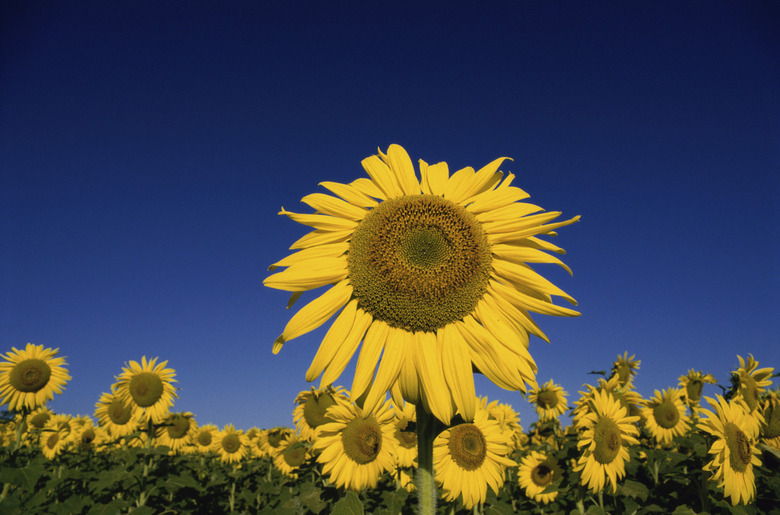Why Do Sunflowers Always Face Toward The Sun?
The common sunflower (_Helianthus annuus_) is an annual wildflower native to western North America and northern Mexico. Like other flowering plants, the sunflower's leaves contain photoreceptors that "see" light, specifically the red and far-red portion of the visible light spectrum.
The common sunflower (Helianthus annuus) is an annual wildflower native to western North America and northern Mexico. Like other flowering plants, the sunflower's leaves contain photoreceptors that "see" light, specifically the red and far-red portion of the visible light spectrum. In a response referred to as phototropism, the plant changes orientation or moves toward any source of light. Sunflowers, however, practice heliotropism, meaning they prefer to track the relative position of the sun as it moves across the sky each day.
Structural Triggers
The mechanism that causes the sunflower to follow the sun is triggered by a cascade of events that act on a small piece of vascular tissue called the pulvinus, which is located at the base of leaves and flower buds. Here, a collection of motor cells get bigger or smaller in response to pressure exerted by water against cell walls. As light is received by a leaf pigment called phytochrome, an increase in potassium ion concentration causes these specialized cells on the underside of the leaf or bud to swell with water and push the plant to face the direction of the light source, namely the sun. The sunflower takes this process to the extreme by tracking the sun's position from east to west during the day, even on cloudy days.
- The common sunflower (Helianthus annuus) is an annual wildflower native to western North America and northern Mexico.
- Like other flowering plants, the sunflower's leaves contain photoreceptors that "see" light, specifically the red and far-red portion of the visible light spectrum.
Sunflowers do not wilt at night or close as some flowering plants do in response to a lack of light. Instead, they turn toward the east to seemingly await sunrise.
Increased Pollination
There are a few proposed theories as to why sunflowers follow the sun, aside from the obvious benefit of enhancing photosynthesis. One theory is to encourage insects to bask in the warmth of the sun-kissed disc-shaped face of the giant flower head and promote pollination. According to a 2002 study published in the American Journal of Botany, heliotropism may also play a role in pollen germination. The researchers found that sun-tracking flowers received 40 percent more pollen grains and showed 32 percent more pollen germination than flowers forced to remain stationary.
Daily Rhythms
Biological rhythms may also be involved in this phenomenon. Like all living things, plants have an internal circadian clock that regulates daily functions. It has been suggested that rhythmic cell expansion that occurs at different times of the day may contribute to the directional orientation and movement of solar-tracking plants like sunflowers.
Changes With Age
For reasons not yet fully understood, the flower head stops moving with the sun once pollination occurs and remains fixed facing east. Sunflower leaves, however, continue to track the sun, albeit with less enthusiasm. Possible explanations for this include a decrease in growth signals and the development of new signals that restrict cell expansion and direct energy toward seed production. The fact that the flower head becomes heavy with maturity may also have something to do with it, as well as reduced flexibility caused by the thickening of stems.
